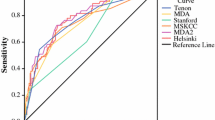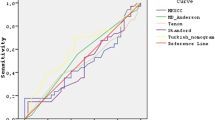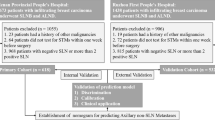Abstract
Background:The standard of care for breast cancer patients with sentinel lymph node (SLN) metastases includes complete axillary lymph node dissection (ALND). However, many question the need for complete ALND in every patient with detectable SLN metastases, particularly those perceived to have a low risk of non-SLN metastases. Accurate estimates of the likelihood of additional disease in the axilla could assist greatly in decision-making regarding further treatment.
Methods:Pathological features of the primary tumor and SLN metastases of 702 patients who underwent complete ALND were assessed with multivariable logistic regression to predict the presence of additional disease in the non-SLNs of these patients. A nomogram was created using pathological size, tumor type and nuclear grade, lymphovascular invasion, multifocality, and estrogen-receptor status of the primary tumor; method of detection of SLN metastases; number of positive SLNs; and number of negative SLNs. The model was subsequently applied prospectively to 373 patients.
Results:The nomogram for the retrospective population was accurate and discriminating, with an area under the receiver operating characteristic (ROC) curve of 0.76. When applied to the prospective group, the model accurately predicted likelihood of non-SLN disease (ROC, 0.77).
Conclusions:We have developed a user-friendly nomogram that uses information commonly available to the surgeon to easily and accurately calculate the likelihood of having additional, non-SLN metastases for an individual patient.
Similar content being viewed by others
REFERENCES
Giuliano AE, Jones RC, Brennan M, Statman R. Sentinel lymphadenectomy in breast cancer. J Clin Oncol 1997; 15: 2345–50.
Albertini JJ, Lyman GH, Cox C, et al. Lymphatic mapping and sentinel node biopsy in the patient with breast cancer. JAMA 1996; 276: 1818–22.
Veronesi U, Paganelli G, Galimberti V, et al. Sentinel node biopsy to avoid axillary dissection in breast cancer with clinically negative lymph-nodes. Lancet 1997; 349: 1864–7.
O’Hea BJ, Hill AD, El-Shirbiny AM, et al. Sentinel lymph node biopsy in breast cancer: initial experience at Memorial Sloan-Kettering Cancer Center. J Am Coll Surg 1998; 186: 423–7.
Krag D, Weaver D, Ashikaga T, et al. The sentinel node in breast cancer: a multicenter validation study. N Engl J Med 1998; 339: 941–6.
Veronesi U, Paganelli G, Viale G, et al. Sentinel lymph node biopsy and axillary dissection in breast cancer: results in a large series. J Natl Cancer Inst 1999; 91: 368–73.
Giuliano AE, Haigh PI, Brennan MB, et al. Prospective observational study of sentinel lymphadenectomy without further axillary dissection in patients with sentinel node-negative breast cancer. J Clin Oncol 2000; 18: 2553–9.
Turner RR, Ollila DW, Krasne DL, Giuliano AE. Histopathologic validation of the sentinel lymph node hypothesis for breast carcinoma. Ann Surg 1997; 226: 271–8.
Chu KU, Turner RR, Hansen NM, Brennan MB, Bilchik A, Giuliano AE. Do all patients with sentinel node metastasis from breast carcinoma need complete axillary node dissection? Ann Surg 1999; 229: 536–41.
Kamath VJ, Giuliano R, Dauway EL, et al. Characteristics of the sentinel lymph node in breast cancer predict further involvement of higher-echelon nodes in the axilla. Arch Surg 2001; 136: 688–92.
Cabanes PA, Salmon RJ, Vilcoq JR, et al. Value of axillary dissection in addition to lumpectomy and radiotherapy in early breast cancer. Lancet 1992; 339: 1245–8.
Moore MP, Kinne DW. Axillary lymphadenectomy: a diagnostic and therapeutic procedure. J Surg Oncol 1997; 66: 2–6.
Carter CL, Allen C, Henson DE. Relation of tumor size, lymph node status and survival in 24,740 breast cancer cases. Cancer 1989; 63: 181–7.
American Joint Committee on Cancer. Breast. AJCC Cancer Staging Manual. 6th ed. New York: Springer, 2002: 221–40.
Sosa JA, Diener-West M, Gusev Y, et al. Association between extent of axillary lymph node dissection and survival in patients with stage I breast cancer. Ann Surg Oncol 1998; 5: 140–9.
Hayward J, Caleffi M. The significance of local control in the primary treatment of breast cancer. Arch Surg 1987; 122: 1244–7.
Osteen RT, Harris JR. Patients with early breast cancer benefit from effective axillary treatment. Breast Cancer Res Treat 1985; 5: 17–21.
Orr RK. The impact of prophylactic axillary node dissection on breast cancer survival: a Bayesian meta-analysis. Ann Surg Oncol 1999; 6: 109–16.
Cady B. Case against axillary lymphadenectomy for most patients with infiltrating breast cancer. J Surg Oncol 1997; 66: 7–10.
Giuliano AE, Kirgan DM, Guenther JM, Morton DL. Lymphatic mapping and sentinel lymphadenectomy for breast cancer. Ann Surg 1994; 220: 391–401.
Reynolds C, Rosemarie M, Donohue JH, et al. Sentinel lymph node biopsy with metastasis: can axillary dissection be avoided in some patients with breast cancer? J Clin Oncol 1999; 17: 1720–6.
Teng S, Dupont E, McCann C, et al. Do cytokeratin-positive-only sentinel lymph nodes warrant complete axillary lymph node dissection in patients with invasive breast cancer? Am Surg 2000; 66: 574–8.
Abdessalam SF, Zervos EE, Prasad M, et al. Predictors of positive axillary lymph nodes after sentinel lymph node biopsy in breast cancer. Am J Surg 2001; 182: 316–20.
Rahusen FD, Torrenga H, van Diest PJ, et al. Predictive factors for metastatic involvement of nonsentinel nodes in patients with breast cancer. Arch Surg 2001; 136: 1059–63.
Turner RR, Chu KU, Qi K, et al. Pathologic features associated with nonsentinel lymph node metastases in patients with metastatic breast carcinoma in a sentinel lymph node. Cancer 2000; 89: 574–81.
Weiser MR, Montgomery LL, Tan LK, et al. Lymphovascular invasion enhances the prediction of non-sentinel node metastases in breast cancer patients with positive sentinel nodes. Ann Surg Oncol 2001; 8: 145–9.
Wong SL, Edwards MJ, Chao C, et al. Predicting the status of the nonsentinel axillary nodes. Arch Surg 2001; 136: 563–8.
Viale G, Maiorano E, Mazzarol G, et al. Histologic detection and clinical implications of micrometastases in axillary sentinel lymph nodes for patients with breast carcinoma. Cancer 2001; 92: 1378–84.
Sachdev U, Murphy K, Derzie A, Jaffer S, Bleiweiss IJ, Brower S. Predictors of nonsentinel lymph node metastasis in breast cancer patients. Am J Surg 2002; 183: 213–7.
Mignotte H, Treilleux I, Faure C, Nessah K, Bremond A. Axillary lymph-node dissection for positive sentinel nodes in breast cancer patients. Eur J Surg Oncol 2002; 28: 623–6.
Jakub JW, Diaz NM, Ebert MD, et al. Completion axillary lymph node dissection minimizes the likelihood of false negatives for patients with invasive breast carcinoma and cytokeratin positive only sentinel lymph nodes. Am J Surg 2002; 184: 302–6.
Czerniecki BJ, Scheff AM, Callans LS, et al. Immunohistochemistry with pancytokeratins improves the sensitivity of sentinel lymph node biopsy in patients with breast carcinoma. Cancer 1999; 85: 1098–103.
Cody HS III. Clinical aspects of sentinel node biopsy. Breast Cancer Res 2001; 3: 104–8.
Harrell FE Jr. Regression Modeling Strategies With Applications to Linear Models, Logistic Regression, and Survival Analysis. Springer Series in Statistics. New York: Springer-Verlag, 2001: 568.
Chu KU, Turner RR, Hansen NM, Brennan MB, Giuliano AE. Sentinel node metastasis in patients with breast carcinoma accurately predicts immunohistochemically detectable nonsentinel node metastasis. Ann Surg Oncol 1999; 6: 756–61.
Dowlatshahi K, Fan M, Snider HC, Habib FA. Lymph node micrometastases from breast carcinoma: reviewing the dilemma. Cancer 1997; 80: 1188–97.
Tan LK, Giri D, Panageas K, et al. Occult/micrometastases in axillary lymph nodes of breast cancer patients are significant: a retrospective study with long-term follow-up [abstract]. Proc Am Soc Clin Oncol 2002; 21: 37a.
Gann PH, Colilla SA, Gapstur SM, Winchester DJ, Winchester DP. Factors associated with axillary lymph node metastasis from breast carcinoma: descriptive and predictive analyses. Cancer 1999; 86: 1511–9.
Harrell FE Jr, Lee KL, Mark DB. Multivariable prognostic models: issues in developing models, evaluating assumptions and adequacy, and measuring and reducing errors. Stat Med 1996; 15: 361–87.
Ross PL, Gerigk C, Gonen M, et al. Comparisons of nomogram and urologists’ predictions in prostate cancer. Semin Urol Oncol 2002; 20: 82–8.
Author information
Authors and Affiliations
Corresponding author
Additional information
Drs. Manasseh and Bevilacqua contributed equally to the work.
Dr. Bevilacqua is currently affiliated with Hospital Sírio Libanes, Instituto Brasileiro de Controle do Câncer, and Disciplina de Cirurgia Geral, Departamento de Cirurgia, Faculdade de Medicina da Univerdidade de Sao Paulo. São Paulo, Brazil; Dr. Boolbol is currently affiliated with Beth Israel Medical Center, New York, New York.
Rights and permissions
About this article
Cite this article
Van Zee, K.J., Manasseh, DM.E., Bevilacqua, J.L.B. et al. A Nomogram for Predicting the Likelihood of Additional Nodal Metastases in Breast Cancer Patients With a Positive Sentinel Node Biopsy. Ann Surg Oncol 10, 1140–1151 (2003). https://doi.org/10.1245/ASO.2003.03.015
Received:
Accepted:
Issue Date:
DOI: https://doi.org/10.1245/ASO.2003.03.015




